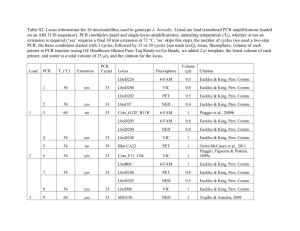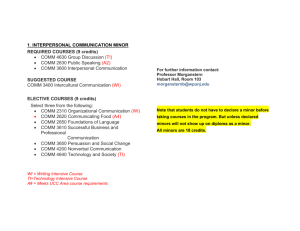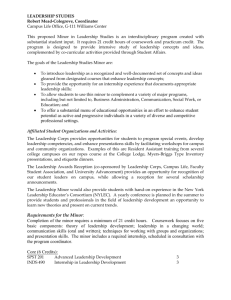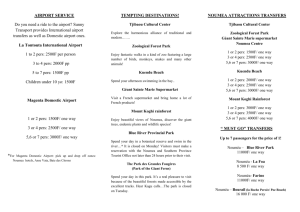Colligyrus depressus - USDA Forest Service
advertisement
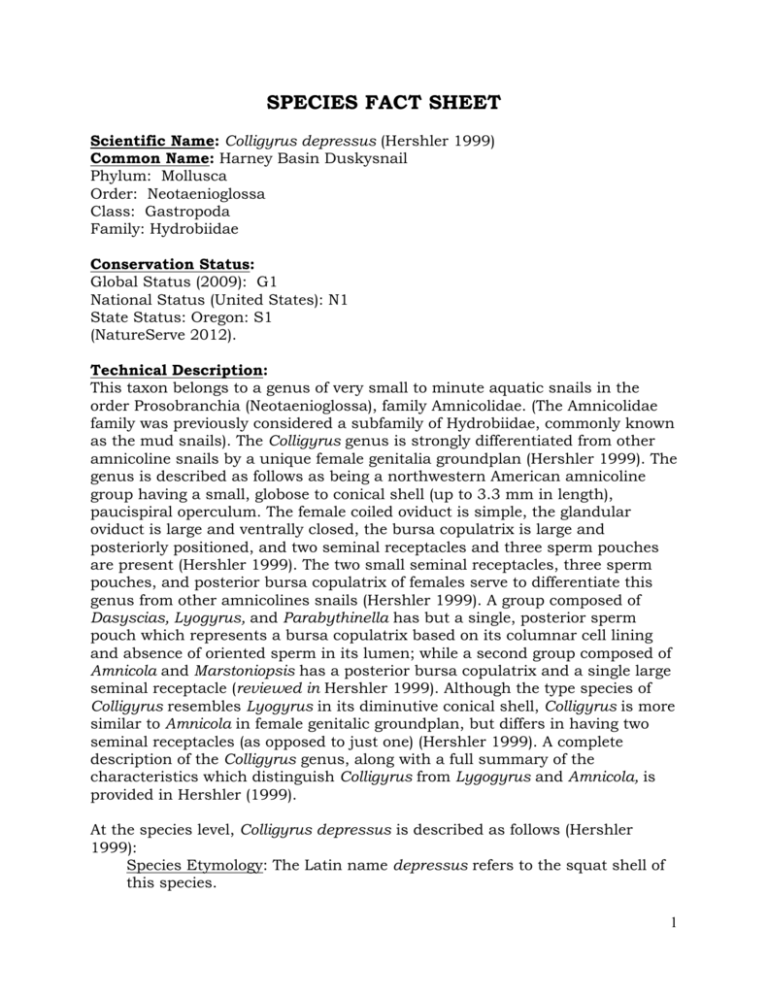
SPECIES FACT SHEET Scientific Name: Colligyrus depressus (Hershler 1999) Common Name: Harney Basin Duskysnail Phylum: Mollusca Order: Neotaenioglossa Class: Gastropoda Family: Hydrobiidae Conservation Status: Global Status (2009): G1 National Status (United States): N1 State Status: Oregon: S1 (NatureServe 2012). Technical Description: This taxon belongs to a genus of very small to minute aquatic snails in the order Prosobranchia (Neotaenioglossa), family Amnicolidae. (The Amnicolidae family was previously considered a subfamily of Hydrobiidae, commonly known as the mud snails). The Colligyrus genus is strongly differentiated from other amnicoline snails by a unique female genitalia groundplan (Hershler 1999). The genus is described as follows as being a northwestern American amnicoline group having a small, globose to conical shell (up to 3.3 mm in length), paucispiral operculum. The female coiled oviduct is simple, the glandular oviduct is large and ventrally closed, the bursa copulatrix is large and posteriorly positioned, and two seminal receptacles and three sperm pouches are present (Hershler 1999). The two small seminal receptacles, three sperm pouches, and posterior bursa copulatrix of females serve to differentiate this genus from other amnicolines snails (Hershler 1999). A group composed of Dasyscias, Lyogyrus, and Parabythinella has but a single, posterior sperm pouch which represents a bursa copulatrix based on its columnar cell lining and absence of oriented sperm in its lumen; while a second group composed of Amnicola and Marstoniopsis has a posterior bursa copulatrix and a single large seminal receptacle (reviewed in Hershler 1999). Although the type species of Colligyrus resembles Lyogyrus in its diminutive conical shell, Colligyrus is more similar to Amnicola in female genitalic groundplan, but differs in having two seminal receptacles (as opposed to just one) (Hershler 1999). A complete description of the Colligyrus genus, along with a full summary of the characteristics which distinguish Colligyrus from Lygogyrus and Amnicola, is provided in Hershler (1999). At the species level, Colligyrus depressus is described as follows (Hershler 1999): Species Etymology: The Latin name depressus refers to the squat shell of this species. 1 Species Diagnosis: Within the genus, this species is diagnosed by being small, with a globose to low-conic shell. Species Description: Shell low-conic, rarely with eroded spire; 1.9 to 2.1 mm in height with 3.5 to 3.75 whorls. Apex often inclined; protoconch of 1.4 to 1.5 whorls, diameter about 0.44 mm; microsculpture of numerous weak spiral lineations. Teleoconch whorls convex, often markedly so, narrowly shouldered. Shell clear to white, translucent. Periostracum tan. Aperture medium-sized, ovate, weakly angled adapically. Outer lip prosocline, weakly sinuate (adapically advanced). Parietal lip narrowly adnate or slightly separated from body whorl; columellar lip without swelling. Umbilicus perforate. Operculum brown in nuclear region, otherwise clear; outer margin without rim. Attachment scar margin slightly thickened along inner edge. Callus weakly developed in nuclear region. Radula with about 170 rows of teeth; ribbon length: 1.4 mm, ribbon width: 88 µm; central tooth width: 22 µm. Cutting edge of central tooth weakly to moderately indented; lateral cusps, 6-7; median cusp rounded or weakly pointed, slightly broader and longer than laterals; basal cusps, 1, sometimes absent on one side; basal tongue slightly shorter than lateral margins, basal sockets deeply excavated. Lateral tooth with horizontal or slightly convex cutting edge; lateral wing slightly longer (125%) than cutting edge; tooth face taller than broad; central cusp rounded, lateral cusps, 3 (inner), 4-5 (outer). Inner marginal teeth with 26-30 cusps; outer marginal teeth with 25-29 cusps. Snout, tentacles, foot light to medium gray. Inner edge of opercular lobe black. Neck unpigmented to medium gray. Pallial roof, visceral coil medium gray to black. Ctenidium absent or represented by a few (3 to 6) small, stubby vestiges; branchial vessel not seen in dissection. Osphradium anteriorly positioned, filling about 20% of pallial cavity length. Ovary about 0.5 whorl, abutting or slightly overlapping posterior stomach chamber, filling less than 50% of digestive gland behind stomach. Distal female genitalia illustrated in Hershler (1999). Bursa copulatrix about 50% of albumen gland length; ovate or clublike, horizontal or obliquely oriented, about 50% overlapped by albumen gland. Bursal duct medium length (50-67% of bursa length), often narrow, sometimes poorly distinguished from bursa. Posterior seminal receptacle small, without duct, overlapping anterior half of bursa copulatrix, positioned near ventral edge of albumen gland. Portions of coiled oviduct adjacent to posterior seminal receptacle often filled with sperm. Anterior seminal receptacle disc shaped. Albumen gland with weak rectal furrow. Albumen gland with short (about 22%) pallial section; capsule gland entirely pallial, composed of two distinct glandular units. Genital opening a small terminal slit. Testis 1.0-1.25 whorl, broadly overlapping stomach chambers, filling about 50% of digestive gland behind stomach. Prostate gland ovate, entirely visceral. Pallial vas deferens a broad tube without bends or undulations; portion of vas deferens in neck straight. Penial lobe arising slightly distal to base. Penial duct narrow throughout. Penis unpigmented (Hershler 1999). 2 Colligyrus depressus differs from C. greggi in its broader shell, absence or vestigial nature of ctenidium, more distal position of penial lobe, longer bursal duct, discoidal shape of the anterior seminal receptacle, division of capsule gland into two distinct units, and slit-like female genital aperture (Hershler 1999). Measurements of selected shell parameters for C. depressus are shown in the table below (extracted from Hershler 1999, Table 1). Data are expressed as mean with standard deviation given below. Measurements are given in mm. n = number of specimens, SH = shell height, SW = shell width, HBW = height of body whorl, WBW = width of body whorl, AH = aperture height, AW = aperture width, SS = shell width/shell height, WH = number of shell whorls. Colligyrus depressus (USNM 860756; n = 15) Mean Standard deviation SH SW HBW WBW AH AW SS WH 1.98 1.78 1.73 1.52 1.05 0.93 0.9 3.6 0.05 0.06 0.04 0.03 0.05 0.04 0.03 0.13 See Appendix 4 for an illustration of the shell and electron micrographs of the shell, operculum, and radula of this species. Details of the genitalia of this species are illustrated in Hershler (1999). Life History: Little is known regarding the feeding habits, growth, reproduction, or life span of this recently described species. Hydrobiidae snails, in general, feed on algae, diatoms, and detritus. Similar to most species in the family, Colligyrus depressus has both male and female individuals (Hershler 1999). Females of this species are oviporous (producing eggs that hatch outside the body), in contrast with viviparous hydrobiids which produce eggs that are hatched within the pallial gonoduct of the body and born alive (Hershler 1999). Oviporous females in this family are known to lay eggs in single capsules on the leaves or stems of water plants. Range, Distribution, and Abundance: Colligyrus depressus is thus far known only from Silvies River Drainage in the Harney Lake basin, Harney County, southeast Oregon, and from FremontWinema National Forest, Lake County, southern Oregon. Known sites in Harney County include the type locality (a series of unnamed springs near Cricket Creek) and an unnamed spring at the source of Spring Creek (Malheur National Forest) in the vicinity of the type locality (Hershler 1999, Deixis MolluscDB 2009, Smithsonian NMNH database 2012, Vetter 2012, pers. comm., Hershler 2012, pers. comm.). The Lake County record (FS NRIS database 2012) is from Cliff Spring or a nearby spring in Fremont-Winema National Forest. This record represents a significant range extension from that 3 which was presented in Hershler (1999), but not so much as to be surprising, considering how little is known about the distribution of this recently described species (Hershler 2012, pers. comm.). According to Ed Johannes (2009 pers. comm.), historical aspects of the geology coupled with current fish fauna patterns indicate that this species is probably not associated with other Great Basin Drainages, but should rather be thought of as a Columbia River Drainage species that has been captured by the Great Basin Drainage. Springs in the Malheur Lake Basin south of Burns were not found to contain this species (Johannes 2009, pers. comm.). Robert Hershler’s Great Basin hydrobiid project, which involved visits to over 2,000 Great Basin sites, detected this species only in the vicinity of the type locality (Hershler 1999, NatureServe 2012). Note that there is a Colligyrus species in the John Day area (Strawberry Lake and Strawberry Creek) whose identity is uncertain, although it is suspected to be a closely related but different species (Johannes 2009, pers. comm.). Forest Service/BLM Lands: The species is documented on Malheur and Fremont-Winema National Forests. It is suspected on the Ochoco National Forest and Burns District BLM land. The status for Burns BLM is based on BLM land being in very close proximity to known records on Spring Creek, ¼ mile upstream. Abundance: Abundance estimates of this species have not been conducted, although Richard Vetter (2012, pers. comm.) noted very high abundance at one large spring site where this species occurs—most rocks had many snails attached, and thousands of individuals are thought to have been present. Known collections range from 5 to 151 specimens (Deixis MolluscDB 2009, Smithsonian NMNH database, FS NRIS database 2012). Habitat Associations: The habitat for this species is known as shallow (0 to 5.1 cm deep), cold (11° C) rheocrines (springs and spring runs) at elevations of 1365 to 1423 m (4480 to 4670 ft.) with surrounding vegetation of sage scrub (Deixis MolluscDB 2009, Hershler 1999). Specific descriptions for two of the private-land springs where this species has been found are as follows: (1) cold spring with silt-cobble (travertine; basalt with vesicules), Rorippa, and mosses; (2) cold spring with somewhat steep run, basalt cobbles, abundant Rorippa and Hydrocotyle ranunculoides (Deixis MolluscDB 2009). Associated freshwater mollusks at these sites include Pristinicola hemphilli, Physella, sphaeriids, and Menetus (Deixis MolluscDB 2009). The Malheur National Forest site where this species occurs is a cold water, large perennial spring flowing out of a lava cliff (Vetter 2012, pers. comm.). The springs create a fast, cold flow about 15 ft. wide and one to eight in. deep. Fish are present in the area. Yellow monkey flower (Mimulus sp.), water cress (Nasturtium sp.), and other aquatic and riparian 4 plants are prevalent. This relatively large spring is one of a series of smaller springs in the area, and appears to be a secure habitat for this species due to lava boulder field offering protection from grazing; however, part of the site is a favorite local recreational site that receives a high level of riparian disturbance and recreation in the creek (Vetter 2013, pers. comm.). A photograph of the type locality is provided in Hershler (1999). Threats: Any modification of the cold-water spring environment where this species lives could be a potential threat to its survival. A number of habitat threats have been identified for this species: Livestock grazing: Livestock grazing and spring development for livestock, particularly when float valves are not used, are considered to be major threats to this species (Johannes 2009, pers. comm., Vetter 2012, pers. comm.). Currently livestock grazing is not a threat at the Forest Service site where this species has been documented (Vetter 2012, pers. comm.). Water-quality degradation by big game hunting activities: It is legal in Oregon for hunters to bait deer and elk (along with many other animals) on Forest Service land. Although the Forest Service doesn't allow the use of salt as bait due to resource damage of water, soil, and plants (hunters causing resource damage from salting are subject to federal fines of $200.00-$300.00 and restitution costs) this is a still a frequent illegal activity by bow hunters on the southern areas of the Malheur National Forest (Vetter 2012, pers. comm.). Rock salt, mineral salt, water softeners, and other forms of salt and nutrients are placed on the ground near springs and pools where the animals are expected to visit for water in this dry environment. Large quantities of salt (e.g., 50 lb. bags or more) are often spread near water to attract big game for the bow hunter, resulting in the leaching of salt into the water, and raising the salinity of the water (Vetter 2012, pers. comm.). Salting by hunters is not an issue at the Malheur National Forest spring where this species is documented, but could be at any time and is considered a prominent threat at other springs in the area where the species may occur (Vetter 2012, pers. comm.). Salting at springs with high flow rates, such as this site, may not be affected to the degree that smaller springs and seeps would be, due to the dilution rate (Vetter 2013, pers. comm.). Recreation: Recreational activity may be a threat to this species at some sites. The spring source on the Malheur National Forest where this species is documented occurs one half mile upstream from a road access point where a dispersed camping area is located. Although the camping area on the spring flow is heavily used, the spring itself is difficult to access and relatively undisturbed by recreation activities due to the presence of lava boulders (Vetter 5 2012, pers. comm.). Fire & Fire Retardant Chemicals: The area in eastern Oregon where this species occurs is prone to catastrophic wildfires during periods of drought. In 1990, Pine Spring Basins Fire burned 73,700 acres of federal and private lands, and in 2007, part of the same landscape was burned by the Egley Fire, which covered over 140,000 acres. The spring on Malheur National Forest land where this species occurs was partially burned by the Egley fire and many other springs in the area were affected (Vetter 2013, pers. comm.). In addition to fire itself, fire-retardant chemicals commonly applied to forests to fight wildfires may also pose threats to this species (Vetter 2012, pers. comm.). While the toxicity of these chemicals to snails is largely unknown, many other aquatic organisms are highly sensitive to fire-retardants in both laboratory studies and field applications (Little & Calfee 2002a, 2002b, Fox News 2012). Fire retardant use is restricted in riparian areas and stream channels, which should limit this threat. Conservation Considerations: Inventory: This species was known for many years only from the Harney County type locality springs, until, in 2010, it was discovered in Lake County (Fremont-Winema National Forest), and in 2011, a new site in Harney County located (a spring on nearby Malheur National Forest land). These findings highlight the potential for additional undiscovered sites in the large area between the Lake and Harney County sites, as well as in the vicinity of the known sites (Vetter 2012, pers. comm.). In Eastern Oregon (Harney County), springs in the Silvies River Drainage are the most logical places to survey for this species (Johannes 2009, pers. comm.). There are a large number of springs in the area, and much of the potential habitat for this species has not been surveyed (Johannes 2009, pers. comm.). Other springs in the area where the species may occur include: (1) an unnamed spring on BLM land, roughly a 2/3 mile northeast of Spring Creek Spring and 2/3 mile southwest of Turner Ranch. This spring has not been surveyed for the snail, but its occurrence is likely considering the proximity to and connectivity with the Spring Creek Spring site on Forest Service Land (Vetter 2012, pers. comm.). (2) an unnamed spring on BLM land in Carlon Canyon, roughly one mile southeast of the type locality springs. This spring is not known to have been surveyed for the snail. (3) Miller Flat Spring, approximately 40 miles to the west of known sites for this species, in a different subbasin (Malheur River Subbasin), on Forest Service land. This is a tiny spring, heavily utilized by cattle. One 6 or more snails morphologically similar to C. depressus were observed in 2012, but identification has not yet been verified (Vetter 2012, pers. comm.). In Southern Oregon, additional springs in Klamath and Lake Counties (Fremont-Winema National Forest) should be identified and examined for this under-surveyed taxon (Hershler 2012, pers. comm.). Management: Manage new and known sites and their associated watersheds to reduce the impacts of grazing, water diversions, recreation, and other practices that may adversely affect water quality. Habitat protection, including maintenance of water quality and substrate conditions, would likely benefit and help maintain this species. Prepared by: Sarah Foltz Jordan, Xerces Society Date: 30 November 2012 Edited by: Sarina Jepsen, Xerces Society Date: 6 December 2012 Final Edits by: Rob Huff, BLM/FS Portland, Oregon Date: 20 February 2013 ATTACHMENTS: (1) References (2) List of pertinent or knowledgeable contacts (3) Map of Species Distribution (4) Illustration and Scanning Electron Micrographs of Species (5) Photographs of Species Habitat (6) Aquatic Gastropod Survey Protocol, including specifics for this species ATTACHMENT 1: References: Deixis MolluscDB database. 2009. An unpublished collection of mollusk records maintained by Ed Johannes. Forest Service NRIS Database: Wildlife observations. 2012. GIS export provided to Sarah Foltz Jordan, Xerces, by Michele Huffman, ISSSSP, May 2012. Data origin: Forest Service, ORIG_FID: 2505116. 7 Fox News. 2012. Debate over fire retardant toxicity rages in West. Published June 22, 2012. Associated Press. Available at: http://www.foxnews.com/us/2012/06/22/debate-over-fire-retardant-toxicityrages-in-west/ (Accessed Sept. 2012). Frest, T.J. and E.J. Johannes. 1995. Interior Columbia Basin mollusk species of special concern. Final report: Interior Columbia Basin Ecosystem Management Project, Walla Walla, WA. Contract #43-0E00-4-9112. 274 pp. plus appendices. Hershler R. 1999. A systematic review of the hydrobiid snails (Gastropoda: Rissoidea) of the Great Basin, western United States. Part II. Genera Colligyrus, Fluminicola, Pristinicola, and Tryonia. The Veliger 42(4): 306-337. Hershler, Robert. 2012. Research zoologist, Smithsonian National Museum of Natural History, Washington DC. Personal communication with Sarah Foltz Jordan. Johannes, Ed. 2009. Mollusk consultant and curator, Deixis Consultants, Seattle-Tacoma, Washington. Personal communication with Sarah Foltz Jordan. Little, E.E. and R.D. Calfee. 2002a. Environmental implications of fireretardant chemicals. U.S. Geological Survey, Columbia Environmental Research Center, Columbia, Missouri. 9 pp. Little, E.E. and R.D. Calfee. 2002b. Effects of fire-retardant chemical products on fathead minnows in experimental streams. U.S. Geological Survey, Columbia Environmental Research Center, Columbia, Missouri. 28 pp. NatureServe. 2012. “Colligyrus depressus.” NatureServe Explorer: An online encyclopedia of life [web application]. Feb. 2009. Version 7.1. NatureServe, Arlington, Virginia. Available at: http://www.natureserve.org/explorer/ (Accessed 19 Sep. 2012). Smithsonian National Museum of Natural History: Invertebrate Zoology Collection. Online database. Available at: http://collections.nmnh.si.edu/search/iz/ (Accessed 25 June 2012). Vetter, Richard. 2012. Fisheries biologist, Malheur National Forest, Hines, OR. Personal communication with Sarah Foltz Jordan. Vetter, Richard. 2013. Fisheries biologist, Malheur National Forest, Hines, OR. Personal communication with Rob Huff. 8 ATTACHMENT 2: List of pertinent, knowledgeable contacts: Robert Hershler. Smithsonian National Museum of Natural History, Washington DC. Ed Johannes, Deixis Consultants, Seattle-Tacoma, Washington. Richard Vetter, Forest Service, Malheur National Forest, Oregon. 9 ATTACHMENT 3: Maps of Species Distribution Records of Colligyrus depressus in Oregon relative to Forest Service and BLM lands. The southwest record is a recent record from Fremont-Winema National Forest; the northeast records from Malheur National Forest and surrounding area are magnified below. 10 Records of Colligyrus depressus in Eastern Oregon relative to Forest Service and BLM land. One record in this area is from Forest Service land; the others are in close proximity to BLM land. 11 ATTACHMENT 4: Species Illustration and Scanning Electron Micrographs of Shell of Colligyrus depressus holotype (#883876), 1.7 mm. Extracted from Hershler (1999); used with permission. 12 Scanning electron micrographs of shell, operculum, and radula of Colligyrus depressus, USNM 860756. A. Shell (height 1.8 mm). B. & C. Shell apex. Bars = 170 µm, 188 µm, respectively. D. Operculum, outer surface. Bar = 230 µm. E. Operculum, inner surface. Bar = 240 µm. F. Central radular teeth. Bar = 10 µm. G. Lateral radular tooth. Bar = 13 µm. H. Inner marginal tooth. Bar = 12.5 µm. I. Outer marginal teeth. Bar = 11.5 µm. Extracted from Hershler (1999); used with permission. 13 ATTACHMENT 5: Photographs of Species Habitat. Photograph of type locality for Colligyrus depressus (unnamed springs, Cricket Creek, Silvies River drainage, Harney County, Oregon). Photograph by Donald Sada, extracted from Hershler (1999), used with permission. Photograph of recently discovered Forest Service site for Colligyrus depressus (unnamed spring, Spring Creek, Silvies River drainage, Harney County, Oregon). Photograph by Richard Vetter, used with permission. 14 ATTACHMENT 6: Aquatic Gastropod Survey Protocol, including specifics for this species: Survey Protocol Taxonomic group: Aquatic Gastropoda How: Please refer to the following documents for detailed mollusk survey methodology: 1. General collection and monitoring methods for aquatic mollusks (pages 6471): Frest, T.J. and E.J. Johannes. 1995. Interior Columbia Basin mollusk species of special concern. Final report: Interior Columbia Basin Ecosystem Management Project, Walla Walla, WA. Contract #43-0E00-49112. 274 pp. plus appendices. 2. Standard survey methodology that can be used by field personnel to determine presence/absence of aquatic mollusk species in a given waterbody, and to document species locations and habitats in a consistent format: Duncan, N. 2008. Survey Protocol for Aquatic Mollusk Species: Preliminary Inventory and Presence/Absence Sampling. Version 3.1. Portland, OR. Interagency Special Status/Sensitive Species Program. U.S. Department of Interior, Bureau of Land Management, Oregon/Washington and U.S. Department of Agriculture, Forest Service, Region 6. 52 pp. [Available at: http://www.fs.fed.us/r6/sfpnw/issssp/species-index/faunainvertebrates.shtml]. Species-specific Survey Details: Colligyrus depressus This species was known for many years only from the Harney County type locality springs, until, in 2010, it was discovered in Lake County (FremontWinema National Forest), and in 2011, a new site in Harney County located (a spring on nearby Malheur National Forest land). These findings highlight the potential for additional undiscovered sites in the large area between the Lake and Harney County sites, as well as in the vicinity of the known sites (Vetter 2012, pers. comm.). In Eastern Oregon (Harney County), springs in the Silvies River Drainage are the most logical places to survey for this species (Johannes 2009, pers. comm.). 15 There are a large number of springs in the area, and much of the potential habitat for this species has not been surveyed (Johannes 2009, pers. comm.). The private-land type locality was last surveyed in 2000 and is probably in need of resurvey if permission can be granted. In 2011, a new site was discovered at a spring on nearby Forest Service land, highlighting the potential for additional undiscovered sites in the area (Vetter 2012, pers. comm.). Other springs in the area where the species may occur include: (1) an unnamed spring on BLM land, roughly a 2/3 mile northeast of Spring Creek Spring and 2/3 mile southwest of Turner Ranch. This spring has not been surveyed for the snail, but its occurrence is likely considering the proximity to and connectivity with the Spring Creek Spring site on Forest Service Land (Vetter 2012, pers. comm.). (2) an unnamed spring on BLM land in Carlon Canyon, roughly one mile southeast of the type locality springs. This spring is not known to have been surveyed for the snail. (3) Miller Flat Spring, approximately 40 miles to the west of known sites for this species, in a different subbasin (Malheur River Subbasin), on Malheur National Forest. This is a tiny spring, heavily utilized by cattle. One or more snails morphologically similar to C. depressus were observed in 2012, but identification has not yet been verified (Vetter 2012, pers. comm.). In Southern Oregon, additional springs in Klamath and Lake Counties (Fremont-Winema National Forest) should be identified and examined for this under-surveyed taxon (Hershler 2012, pers. comm.). According to Ed Johannes (2009 pers. comm.), historical aspects of the geology coupled with current fish fauna patterns indicate that this species is probably not associated with other Great Basin Drainages, but should rather be thought of as a Columbia River Drainage species that has been captured by the Great Basin Drainage (Johannes 2009, pers. comm.). Springs in the Malheur Lake Basin south of Burns were not found to contain this species (Johannes 2009, pers. comm.). Robert Hershler’s Great Basin hydrobiid project, which involved visits to over 2,000 Great Basin sites, detected this species only in the vicinity of the type locality (Hershler 1999, NatureServe 2012). Note that there is a Colligyrus species in the John Day area (Strawberry Lake and Strawberry Creek) whose identity is uncertain, although it is suspected to be a closely related but different species (Johannes 2009, pers. comm.). According to Ed Johannes (2009, pers. comm.), this species is best surveyed for in the summer and fall when the water levels are lower and when the vegetation is brown making it easier to locate the springs. Known records are 16 from April, May, August, and September (Deixis MolluscDB 2009, Smithsonian Database 2012, FS NRIS Database 2012). Hand and dip-net collection are the reported methods of collection for this species (Deixis MolluscDB 2009). Both Ed Johannes (2009, pers. comm) and Richard Vetter (2012, pers. comm.) stress the need to look on and under rocks, noting that dozens of individuals may be found aggregated on a single rock (Vetter 2012, pers. comm.). It is not known if this species is photophobic (intolerant of light), but many other Colligyrus species are (Johannes 2009, pers. comm.). Standardized abundance estimates for this species at new and known sites would assist future conservation efforts, since population size is important in evaluating the stability of a species at a given locality. Identification of this species is based on external shell morphology and other characters outlined and illustrated in Hershler (1999) and in this fact sheet. Expert identification of this species is recommended. 17
